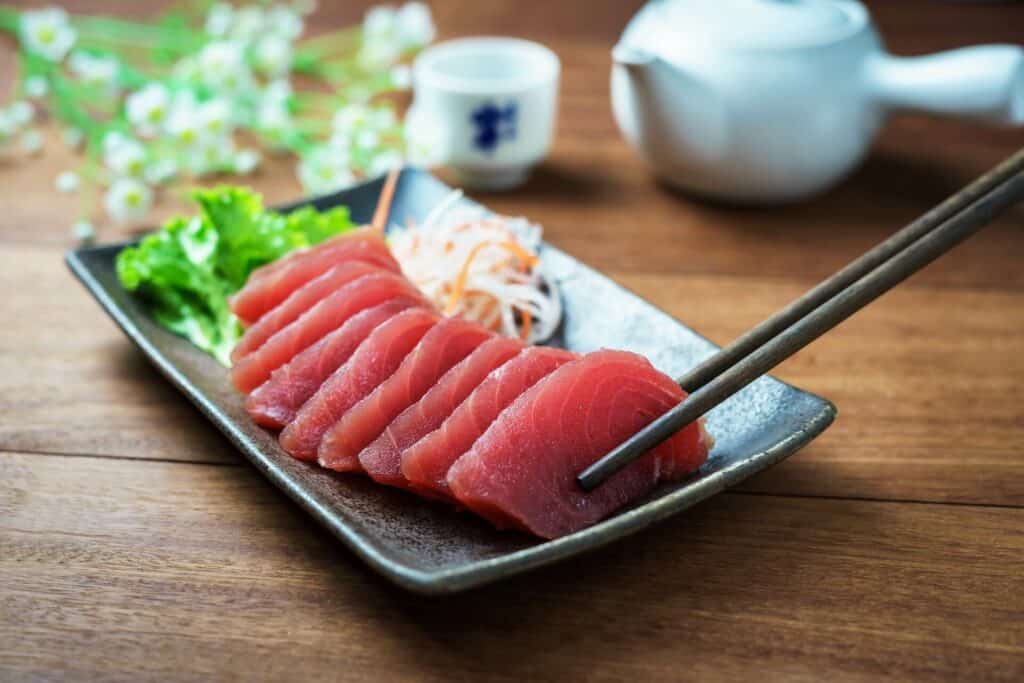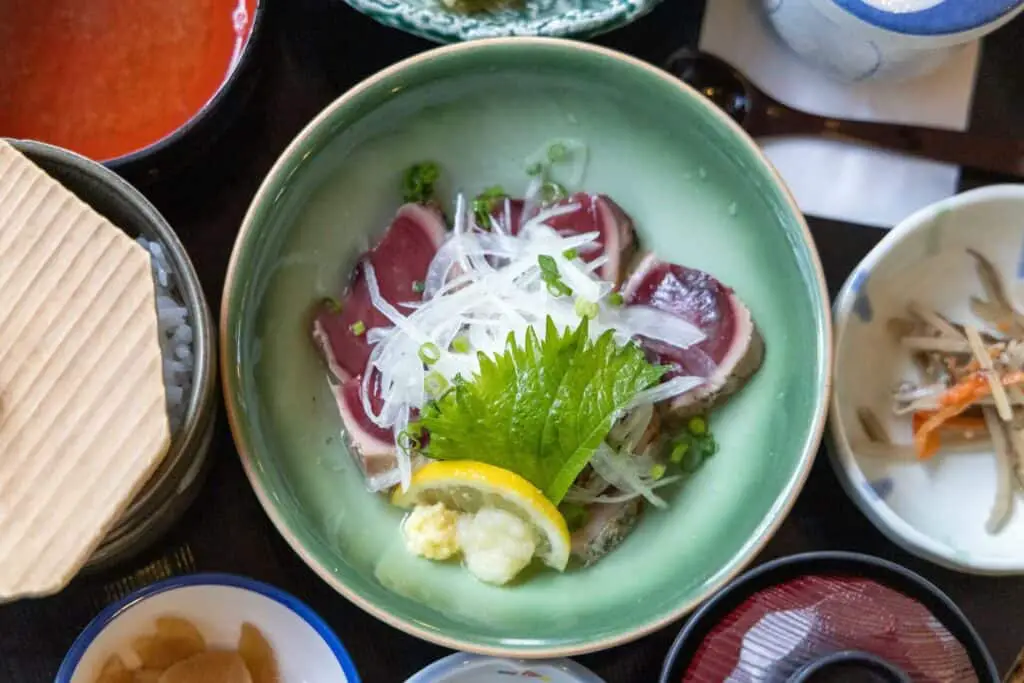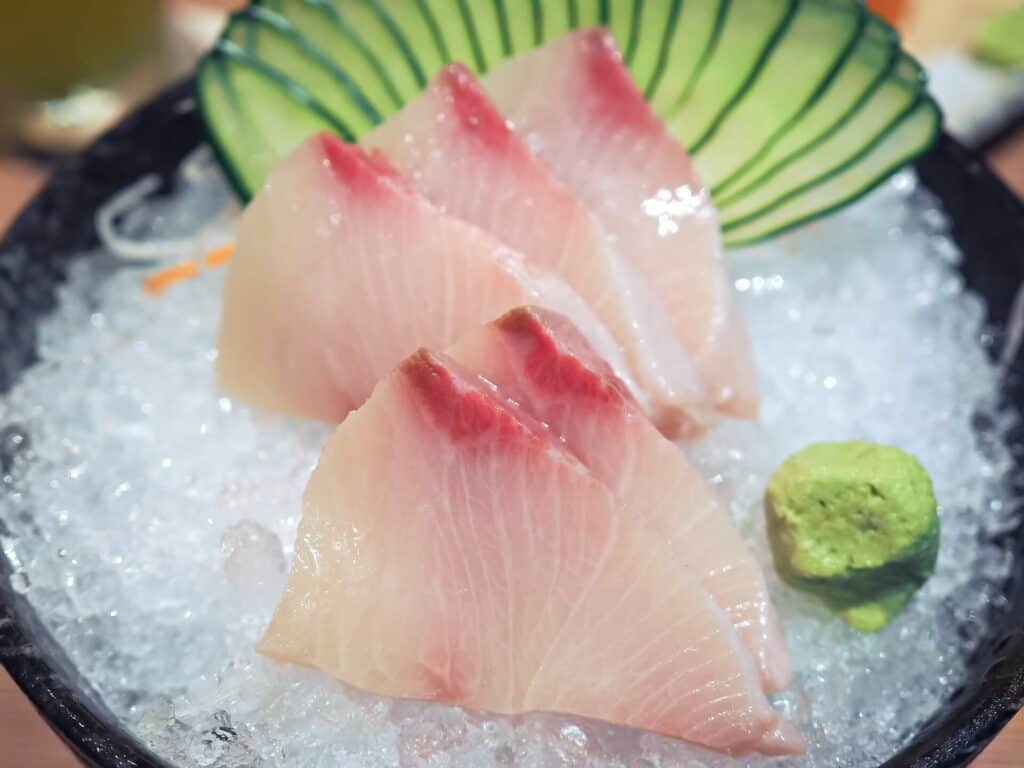Besides sushi, sashimi is probably one of the most popular Japanese delicacies around the globe, with many different variations and types. That is why many who start taking an interest in Japanese food wonder – what is the best sashimi?
The best sashimi is made from otoro (belly) of the sushi-grade bluefin tuna, paired with traditional condiments and garnishes. Yellowfin tuna is considered the best substitute, but many other fish types are suitable as the base for this delicacy, such as salmon, scallops, horse mackerel, halibut, and amberjack.


If you want to learn more about this delicious and popular dish, you can start by reading the article below.
Tuna Sashimi Is the Best Sashimi Variety
Unlike sushi, which can be prepared with rice, seaweed, vegetables, and many other ingredients, the main part of the sashimi dish is fish. Therefore, determining the finest type of this delicacy will mostly depend on the fish that serves as the base. Many professional chefs and kitchen experts give the title of top-tier fish to tuna, known in Japan as maguro.
Best Types of Tuna Fish for Making Sashimi
Maguro may be one of the highest quality and tastiest fish to be eaten raw but bear in mind that not all maguro types are the same. Bluefin tuna is considered to be the most delicious, with dark red meat, a meaty texture, and full flavor.
Still, even different parts of this fish don’t bring the same quality and demand. For example, otoro is bluefin tuna’s belly – it’s fatty and flavorful, which is why it’s most sought-after. Therefore, sashimi made from sushi-grade tuna’s otoro would be considered the best sashimi you can get. Unfortunately, high demand has led to overfishing, and this species of fish is now classified as endangered.
Because of bluefin tuna’s endangered status, yellowfin tuna has taken its place as the top-selling type, with a meaty but mild flavor. Other tunas can also be found on the restaurants’ menus, such as:
- Bigeye, with sweet and rich flavor,
- Albacore, with a pleasantly mild sashimi taste,
- Skipjack, with a strong and fishy flavor.
Which Garnishes and Condiments Are Paired With Tuna?
Although fish is the central part of this dish, it’s never served on its own. In the best restaurants, you’ll be presented with traditional Japanese condiments, such as spicy wasabi or pickled ginger. Aside from these, you’ll also be served with small dipping bowls filled with soy sauce.
For the most authentic experience, traditional Japanese garnishes should be added to the meal, such as shiso leaves or shredded daikon radish. Of course, garnishing the plate doesn’t need to end at that – the chef can also choose to add other things like decorative herbs, vegetables, and lemon slices.

Other Popular Fish Types for Making Sashimi
Of course, tuna’s not the only fish you’ll find on sashimi menus. Moreover, some chefs prefer serving different kinds of raw fish mixed. Which one you’ll like the most will depend on your personal taste. Take a look at the table below to see what other types of fish and seafood are traditionally used for making this dish:
| Type | Japanese name | Characteristics |
| Hokkaido Scallop | Hotate | Tender, sweet, and creamy with white-colored meat |
| Surf Clams | Hokkigai | Sweet with a chewy, almost crunchy texture and white-red meat |
| Horse Mackerel | Aji | Mild-flavored pinkish meat, often compared to the taste of maguro |
| Amberjack | Kanpachi | Tasty, firm flesh that holds balanced fat content |
| Octopus | Tako | Boiled before serving, so the right flavors and texture can be achieved |
| Swordfish | Mekajiki | Fish with high-fat consistency that results in a buttery taste |
Salmon Is One of the Most Popular Sashimi Ingredients Worldwide
We can’t talk about sashimi and not mention salmon since it’s one of the most beloved sushi and sashimi bases in the US. Salmon has a buttery and light taste, not at all fishy, so it’s one of the favorite types of raw fish for many people worldwide.
Many restaurants today serve salmon sashimi as one of their specialties, but did you know that it’s not inherent to traditional Japanese cuisine? The salmon we now eat is mostly aquacultured and parasite-free. However, salmon from Japanese waters was often parasite-infected, which is why it could only be eaten when cooked.

What Is Sushi or Sashimi-Grade Fish?
No matter which fish is part of your next sashimi, it must be sushi or sashimi-grade. What does it mean? Sushi-grade is a label used to describe a fish of the greatest quality that is completely safe to eat raw. It must be bacteria and parasite-free, and in order to achieve that, fishmongers freeze the fish before selling it and treat it in sterilized conditions.
The taste and texture of a fish don’t mean a thing if it’s not the highest-quality kind. Therefore, you must ensure it’s safe for raw consumption, which you can do only if you’re eating in reliable restaurants or buying sashimi from trustworthy fishmongers.

Enjoy the True Delicacy of Japanese Cuisine
Eaten as an appetizer or the main course, this dish tastes divine when prepared right. Although tuna sashimi is considered the highest quality, many other fish species are known as excellent sashimi bases. Therefore, don’t be scared to try them out! Whether you want to make it on your own or enjoy food prepared by experienced chefs, there is no doubt it will soon become one of your favorite dishes.